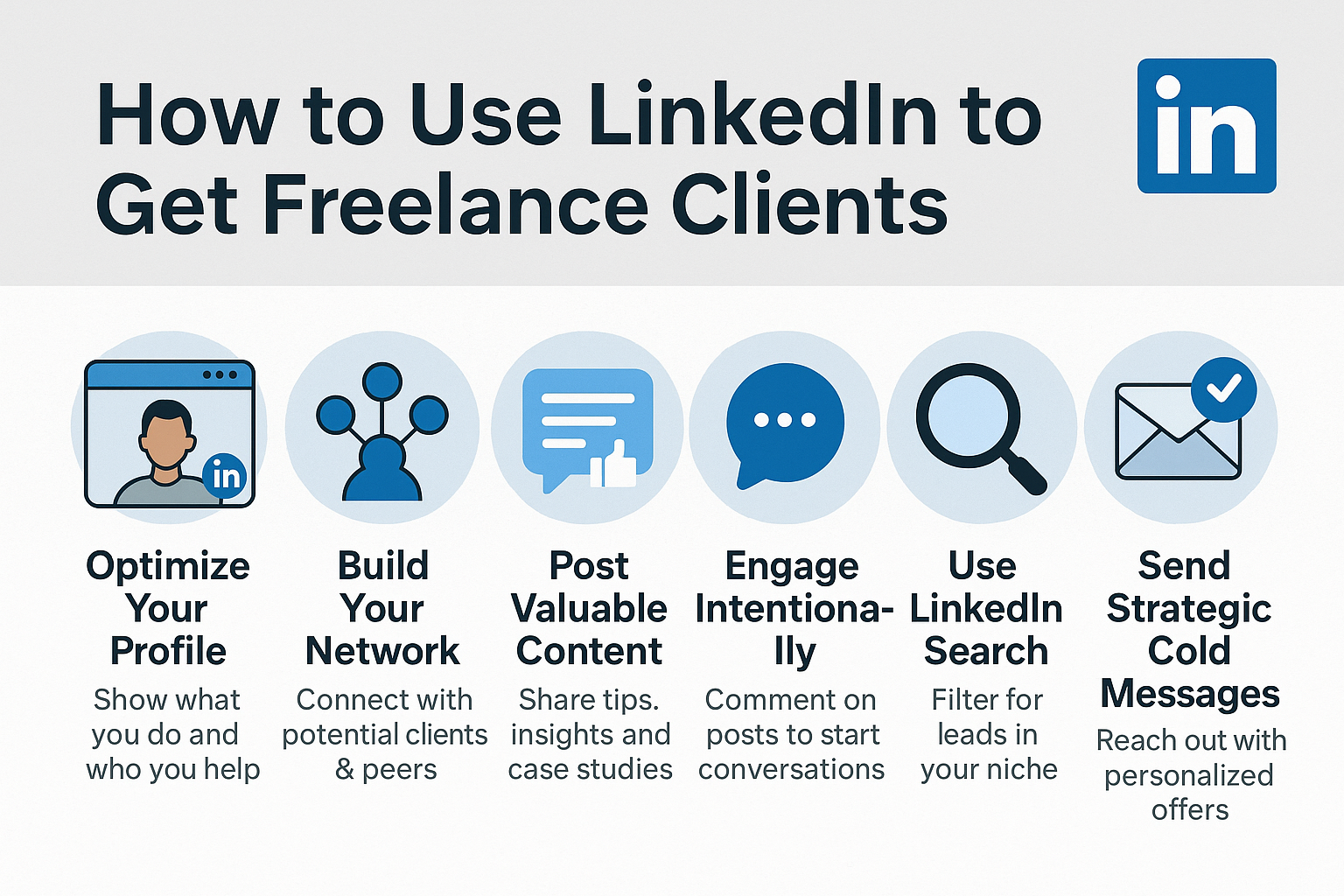LinkedIn is more than a platform for job seekers—it’s one of the most powerful tools freelancers can use to attract high-quality clients. With over 900 million professionals worldwide, LinkedIn offers access to decision-makers, company founders, and hiring managers looking for freelance talent. The best part? You don’t need to spend money on ads to see results. In this article, you’ll learn how to use LinkedIn effectively to find and land freelance clients.
Why LinkedIn Works for Freelancers
Unlike other social media platforms, LinkedIn is built for business. People are already in a professional mindset, which makes it easier to talk about services, value, and collaboration.
Benefits of using LinkedIn:
- Build trust through a professional presence
- Showcase your work and expertise
- Connect directly with decision-makers
- Receive inbound inquiries from ideal clients
Step 1: Optimize Your Profile
Think of your LinkedIn profile as a sales page, not a résumé. It should speak to your ideal client and clearly explain what you offer.
Key elements to optimize:
- Profile Photo
Use a clear, professional headshot. Smile and dress neatly. - Banner Image
Add a custom banner with your name, niche, or tagline. Use Canva or Photoshop. - Headline
Instead of “Freelancer,” say something like:
“I help SaaS startups grow with conversion-focused copywriting.” - About Section
Tell your story. Explain what you do, who you help, and the results you deliver. - Featured Section
Add case studies, articles, or portfolio pieces that showcase your work. - Experience
Include freelance roles with descriptions of your achievements—not just job titles.
Step 2: Build Your Network Strategically
Don’t just add random people. Connect with potential clients, industry peers, and collaborators.
Who to connect with:
- Marketing managers
- Startup founders
- Creative directors
- Content strategists
- Other freelancers (referrals!)
Always personalize connection requests with a short message like:
“Hi [Name], I love your work at [Company]. I’m a freelance [skill]—would love to connect!”
Step 3: Post Valuable Content
Content builds trust and visibility. You don’t need to go viral—just show up consistently.
What to post:
- Quick tips related to your niche
- Lessons from recent projects
- Before-and-after client results
- Common mistakes your clients make
- Questions to spark discussion
- Behind-the-scenes of your process
Post 2–3 times a week to stay on people’s radar. You’ll be surprised how many people watch quietly before reaching out.
Step 4: Engage Intentionally
The LinkedIn algorithm rewards interaction. Spend time commenting on posts by your target audience or industry leaders.
Tips:
- Leave thoughtful, insightful comments
- Ask questions or share a personal perspective
- Like and support posts from people you admire
- Join conversations in your niche
This helps you build visibility and relationships without cold pitching.
Step 5: Use LinkedIn Search to Find Leads
Use LinkedIn’s powerful search filters to find your ideal clients.
Example:
Search:
“Marketing Director” AND “SaaS”
Filter:
- Location (e.g., United States or Europe)
- Industry (e.g., Information Technology)
- Company size (e.g., 11–50 employees)
Then, engage with their content or send a personalized connection request.
Step 6: Send Strategic Cold Messages
When done respectfully, cold messaging works well on LinkedIn. The key is to focus on their needs—not yours.
Message framework:
Hi [Name], I’ve been following your company’s work in [industry]—really inspiring. I’m a freelance [service] who helps [audience] achieve [specific result].
I’d love to share a few quick ideas on how I can help your team. Would you be open to a short chat?
Keep it short, relevant, and client-focused. Avoid copy-pasting generic messages.
Step 7: Stay Consistent
You don’t need a huge following to win on LinkedIn. What matters is showing up consistently and building real connections.
Weekly checklist:
- ✅ Post content (2–3x)
- ✅ Comment on others’ posts (5–10x)
- ✅ Send personalized connection requests (5–10)
- ✅ Follow up with leads
- ✅ Track responses and pitches
Use tools like Notion or Google Sheets to manage outreach and responses.
Bonus Tips
- Add “Freelance [Your Service] | Available for New Projects” to your headline
- Include a “Hire Me” call-to-action in your About section
- Use the LinkedIn Creator Mode for access to more features
- Share client testimonials as quote graphics or videos
Final Thoughts: LinkedIn = A Goldmine for Freelancers
LinkedIn is one of the most underused but high-impact platforms for freelancers. With a clear profile, consistent content, and smart engagement, you can attract inbound leads and build long-term relationships with serious clients.
Start small. Stay consistent. And watch as your freelance business grows—one connection at a time.

